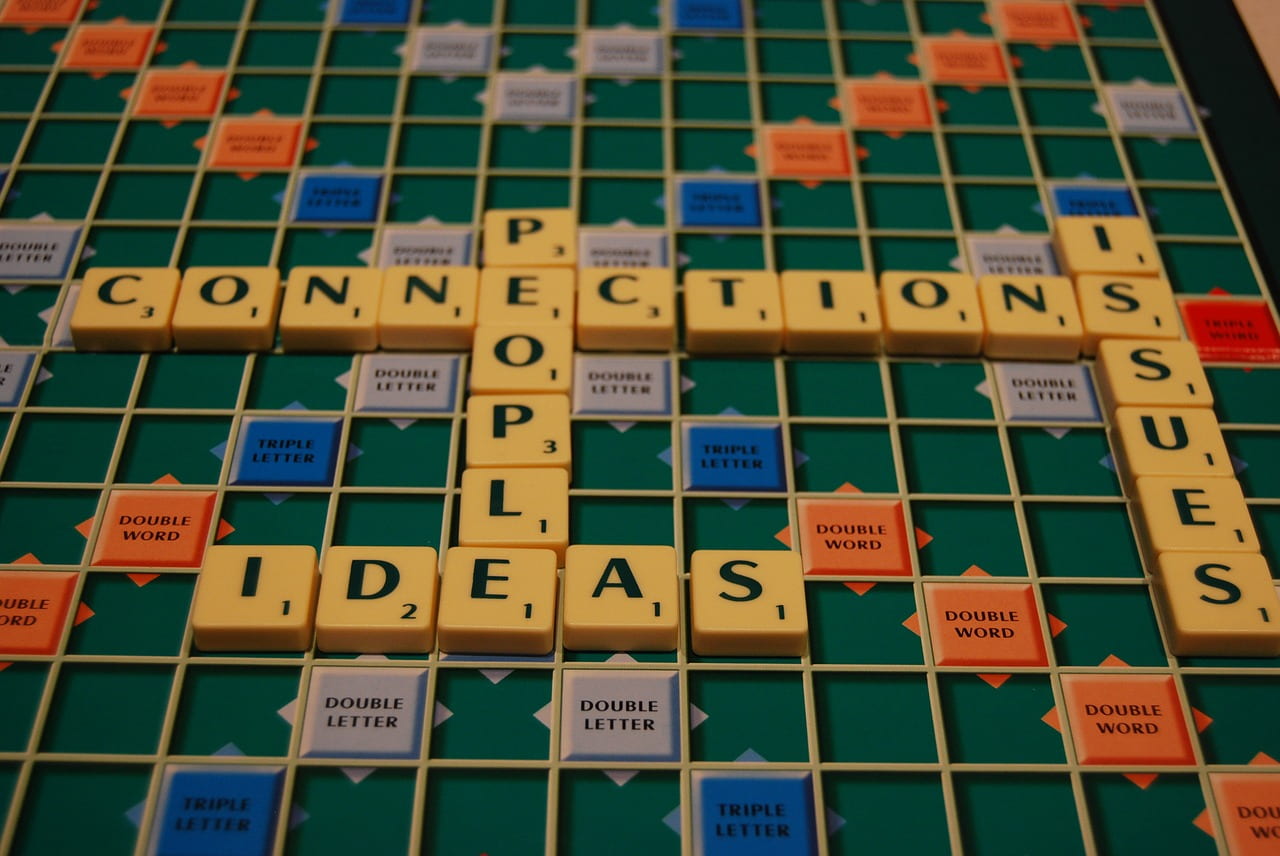(Reflecting on my learning in ETL523 Modules 4, 5 & 6)
“Digital leaders understand that we must put real-world tools in the hands of students and allow them to create artefacts of learning that demonstrate conceptual mastery. This is an important pedagogical shift as it focuses on enhancing essential skill sets—communication, collaboration, creativity, media literacy, global connectedness, critical thinking, and problem solving – that society demands….Leaders need to be the catalysts for change…..Digital leadership begins with identifying obstacles to change and specific solutions to overcome them in order to transform schools in the digital age” (Sheninger, 2017).
Notably, in terms of creating a productive digital learning environment, Sheninger (2017) identifies ‘7 pillars for digital leadership in education’ as: communication, public relations, branding, student engagement/learning, professional growth/development, re-envisioning learning spaces and environments, and opportunity.
Rather than avoid global connections and social media, and rather than limit our students (forcing them to go ‘underground’ with a secret world of digital environments of their own making) we need need to learn how to embrace it safely and productively as global digital citizens (Ohler, 2011). We also need our school principals and supervisors to help promote a community of practice and positive learning environments by being “willing to listen, delegate, distribute, empower, and step out of the way of the learning” (Lindsay, 2016, p.110).
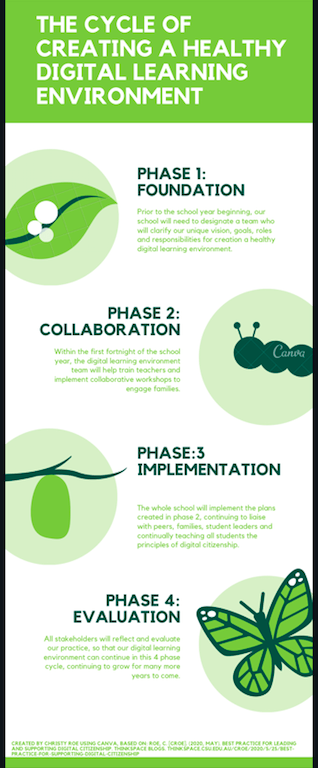
Utilising the readings for modules 4, 5 and 6, as well as a few of my own, following the 6 month multi-phase structure suggested by Chen & Orth (2013), Cofino (2012) and Common Sense Media (n.d.) which begins prior to the start of the school year, we can complete the following 4 phases:
-
Prior to the school year beginning, school contexts need to begin phase 1 by clarifying our unique vision, goals, roles and responsibilities:
- First. form a strong team of information and digital technology leaders (Chen & Orth, 2013; Common Sense Media, n.d.). (See my previous 9 blog posts on creating a school Community of Practice or the evaluation of practice via the 3 blog posts on Quality Teaching Framework/Rounds and also this video on Teacherpreneurs from the Centre for Teaching Quality for motivation!)
- Create and deliver an environmental scan utilising this template for a ‘Situational Analysis’ by Christy Roe (based on suggestions from) the resources provided by Hague & Payton (2010), and/or Pashiardis (1996), particularly as shown in the hexagon images below:
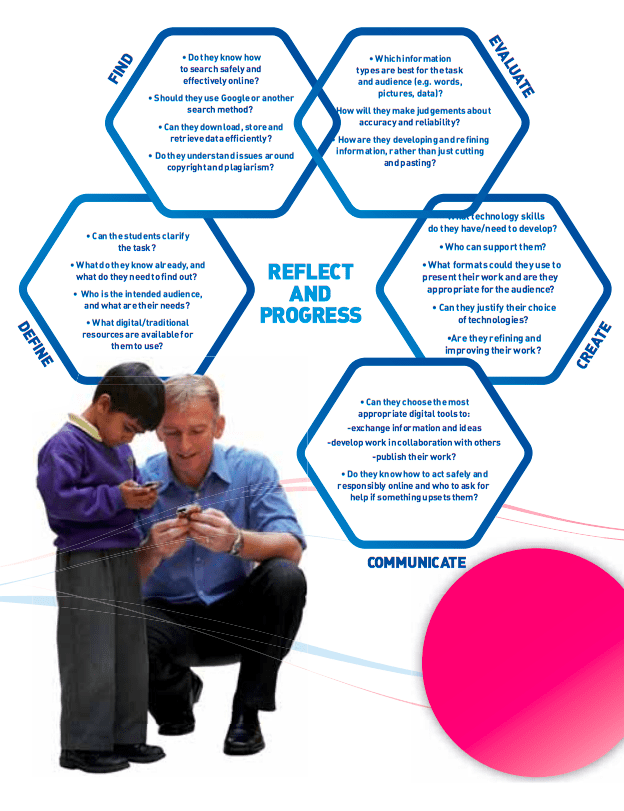
Digital Literacy Planning Tool ‘Reflect & Progress’ image by Hague & Payton, 2010, p.47 - Implement a technology audit (such as this one created by Christy Roe) and/or bullying survey (such as this one created by the University of South Australia) (Chen & Orth, 2013).
- Facilitate the formulation of policies, procedures or guidelines such as an acceptable use policy (using a questionnaire such as this one created by Christy Roe) based on the policy created by the administration (such as those listed in the resources section below), including cohesive terminology that we will utilise as a school (Common Sense Media, n.d.), e.g. linking the Positive Behaviour for Learning Behaviour Matrix or Code of Student Conduct to the school’s “Acceptable use Policy (AUP), Responsible Use Guidelines (RUG), Acceptable Use Agreement (AUA), Internet Use Policy (IUP), Bring Your Own Device (BYOD), or Bring Your Own Technology (BYOT)” etc.
- Liaise with others in our personal learning networks (PLN) (Sheninger, 2017) to map the digital citizenship areas of the syllabus or curriculum documents (NESA / ACARA), find examples of a digital citizenship scope and sequence (such as this (2011) one by Mike Ribble), develop sample lessons or units of work, and accumulate appropriate resources (such as those provided in the resources section below)–made available to all stakeholders (Common Sense Media, n.d.).
- Allow teacher librarians (and the school leadership teams) to readily undertake the role of information leaders who ‘meet the students where they are,’ recognising that there may not only be gaps in terms of technology access, or information access, but there may also be an (intergenerational) gap between what some view as the purpose of technology – i.e. is the purpose of technology to assist in informing, socialising or varying degrees of both, and what is true for the individuals in each school or home context? (Levinson, 2010, p.11).
2. In phase 2, within the first fortnight of the school year, we must train teachers and engage families:
“Alignment between school and home with regards to digital citizenship and healthy digital usage is a hallmark of a 21st-century school. A community-wide understanding of the norms, rules of behaviour, rules of engagement, and common practices is necessary for all schools in order to raise an ethical, digital (and real-life) citizen. Without this key parental partnership, these conversations regarding digital citizenship will just become incoherent whispers in the minds of our students, overwhelmed by the louder voices of media, false information, and misunderstanding” (Chen & Orth, 2013).
- As per the circles image from Hague & Payton (2010) (as well as information from Sheninger (2017)), schools and families need to continually foster 21st century learning and digital literacy skills such as: creativity, (innovation), critical thinking, evaluation (and problem solving), cultural and social understanding, collaboration, effective communication, (global collectedness), the ability to find and select information, (media literacy), e-safety and technological functional skills.
- While at the same time, we must also utilise situations of technology misuse as learning opportunities (see the POISE image below) for the students as well as ourselves as adult digital citizens, setting appropriate boundaries, listening student voices, and continuously encouraging digital literacy and digital citizenship (Chen & Orth, 2013).
- Educators as professionals need to get onboard with 21st century learning and nurture safe, culturally aware, global citizenship and global connections for ourselves as well as for and with our students (Hilt, 2011);
- We must ensure that our digital citizenship curriculum not only protects our students in terms of safety, privacy, copyright, fair use or legality issues, but that it also promotes global cultural, gender, socio-economic status, religion, language and ability awareness and a global appreciation of difference (Hilt, 2011).
- Educators who have embraced the need for global digital citizenship and global connections, need to lead by example and have our own safe, culturally aware, positive and professional ‘brand’ or digital footprint, and we also need to help our students create and tailor their own safe, culturally aware and positive digital footprint ‘brand(s)’ (Neilson, 2012).
- The digital citizenship leadership team, or perhaps even the whole staff, need to hold regular meetings and face to face information and collaboration sessions with families to ensure that preferred means of communication are clarified, that families have input into the digital citizenship program and also so that families are given support in implementing policies, procedures and guidelines at home that suit their individual situation(s) (Chen & Orth, 2013; Levinson, 2010).
- Finally, the digital citizenship team need to develop a plan to help students move from digital citizenship to digital leadership by creating a technology peer mentorship or student technology leadership program (such as YesK12.org) (Oxley, 2012; TeachThought Staff, 2018).
3. In phase 3, we must implement our plans:
- Prior to students being given devices, we must workshop the digital citizenship expectations, policy, procedures and guidelines that we created in phase 1 & 2 (Cofino, 2012).
“The message is threefold: (1) helping children become good digital citizens must be an ongoing practice led by families and schools together; (2) having access to a range of technology and global connections through school creates a positive context in which to have these conversations; and (3) students will make mistakes, and it’s our collective responsibility to turn mistakes into learnable moments” (Chen & Orth, 2013).
-
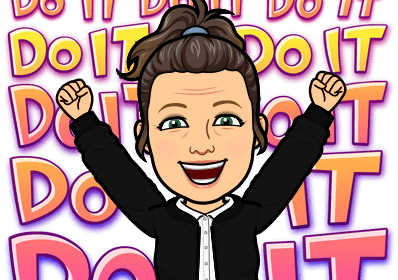
Bitmoji Christy ‘Do it!’ Once students begin to utilise digital devices, we must implement the digital citizenship lessons or units of work that we created in phase 2, with a key focus on 21st century learning skills, boundaries, student voice, digital footprints and global connections.
- We must implement the peer mentorship program that we created in phase 2, including student voice in the consequences for unacceptable behaviours (such as the student court, implied by in the slideshow by Cofino, 2012).
- We must continually check in with families, using the resources and communication devices agreed upon in phase 2.
4. And finally, in phase 4, we will reflect and evaluate:
![Growth Coaching International (n.d.) Growth Framework [Image]](https://thinkspace.csu.edu.au/croe/files/2020/05/Growth-Coaching-International-n.d.-GROWTH-Framework-Image.jpeg)
List of resources for Teachers and Students:
Policies, procedures or guidelines:
- New South Wales Department of Education and Training’s Policies & procedures > Student use of digital devices and online services (implemented January 27, 2020)
- eSafety Commissioner Teacher Resources;
- State of Victoria (Department of Education & Training) – Consent, Acceptable use agreements and Online services (updated November 2018)
- Sample BYOT Policies http://www.teachthought.com/technology/11-sample-education-byot-policies-to-help-you-create-your-own/
- Sample BYOD Policies http://www.k12blueprint.com/byod
- ‘An overview of school AUP’ written by David Warlick (2008)
- New Zealand Ministry of Education – Digital technology: Safe and responsible use in schools (2015). See also Netsafe.
- Code of Conduct (formerly Digital Citizenship Policy) Garibaldi Secondary School (USA).
- Using digital technologies to support learning and teaching – Victorian State Government, Australia
- Edutopia How to create social media guidelines for your school
- Alberta Canada Social Media Policy for School Districts
Resources for digital citizenship lessons:
- In addition to those recommended in my team’s ETL523 Assessment 2 website, there are also:
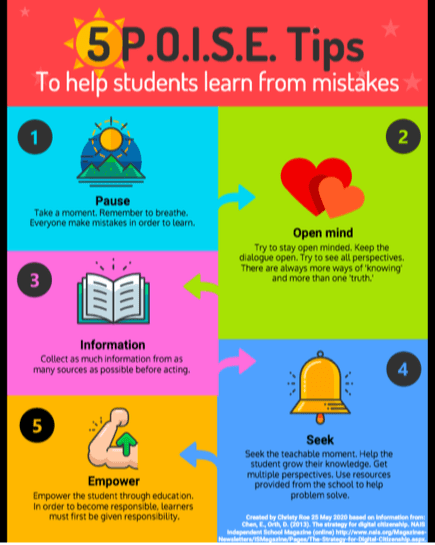
5 POISE Tips Infographic PDF by Christy Roe using information from Chen & Orth (2013) - 5 POISE Tips Infographic (shown here) by Christy Roe, based on information from Chen & Orth (2013) for use by both teachers and families
- Common Craft. (2011). Protecting reputations online. http://www.commoncraft.com/video/protecting-reputations-online.
- Common Sense Media. (2010, November 2). Our Connected Culture. http://youtu.be/L0XQj1anI-E
- eSafety Commissioner Cyberbullying resource
- Digital Life Student Intro Video by Common Sense Media, (2010),
- Overexposed
- Attention young professionals! What’s in your digital baggage?
- DontYouForgetAboutMe. (2007, August 11). Everyone – Think before you post (English). http://youtu.be/4w4_Hrwh2XI.
- ‘I Forgot My Phone’ (YouTube | 2:10 mins) | http://www.youtube.com/watch?v=OINa46HeWg8 CharstarleneTV. (2013, August 22). I forgot my phone. http://www.youtube.com/watch?v=OINa46HeWg8.
Examples of global citizenship programs:
- Global Citizen Diploma program
- Lindsay, J. (2009, March 7). Digiteens go global. http://www.slideshare.net/julielindsay/digiteens-go-global (The Digiteens program is no longer running but information is still available about how to implement it).
- Mirtschin, A. (2012, April 26). Hello little world skypers. http://murcha.wordpress.com/2012/04/26/hello-little-world-skypers-group/
- Morgan, L. (2012, March 19). Skype with an astronaut! http://www.frugalteacher.com/2012/03/skyping-with-astronaut.html
- Internet censorship in China [Tag]. New York Times. https://www.nytimes.com/search?query=internet%20censorship%20in%20china&sort=best
References and further reading
- Beam, C. (2011). Bootleg nation: How strict are Chinese copyright laws? Slate. http://www.slate.com/articles/news_and_politics/explainer/2009/10/bootleg_nation.html.
- Chen, E., Orth, D. (2013). The strategy for digital citizenship. NAIS Independent School Magazine (online) http://www.nais.org/Magazines-Newsletters/ISMagazine/Pages/The-Strategy-for-Digital-Citizenship.aspx.
- Cofino, K. (2012, March 24). Digital citizenship: The forgotten fundamental. http://www.slideshare.net/mscofino/digital-citizenship-the-forgotten-fundamental.
- Common Sense Media (n.d.). Lesson in action: Super digital citizen. http://www.commonsensemedia.org/videos/lesson-in-action-super-digital-citizen
- Growth Coaching International (n.d.) Growth Framework [Image] https://www.growthcoaching.com.au/about/growth-approach?country=au
- Hague, C. and Payton, S. (2010). Digital Literacy Across the Curriculum (Futurelab Handbook). Futurelab. https://www.nfer.ac.uk/publications/FUTL06/FUTL06_home.cfm
- Hilt, L. (2011, October 26). The Case for Cultivating Cultural Awareness. http://plpnetwork.com/2011/10/26/the-case-for-cultivating-cultural-awareness/
- James, C., & Jenkins, H. (2014). Disconnected: Youth, New Media, and the Ethics Gap. MIT Press.
- Levinson, M. (2010). From fear to Facebook: One school’s journey. International Society for Technology in Education.
- Lindsay, J. (2016). The global educator: Leveraging technology for collaborative learning and teaching. International Society for Technology in Education.
- Lindsay. J. (2016, July 19). How to encourage and model global citizenship in the classroom. Education Week http://blogs.edweek.org/edweek/global_learning/2016/07/how_to_encourage_and_model_global_citizenship_in_the_classroom.html
- Lindsay, J. (2014, March 7). Digital citizenship: A global perspective. http://www.slideshare.net/julielindsay/digital-citizenship-a-global-perspective-reduced-size-32020944
- Lindsay, J. (2015, January 8). Leadership for digital citizenship action. http://www.slideshare.net/julielindsay/leadership-for-digital-citizenship-action-acec-2015
- Michaelsen, A. (2013, October 10). Connected educators for connect learners #ce13. http://annmic.wordpress.com/2013/10/10/connected-educators-for-connect-learners-ce13/
- Mirtschin, A. (2012, January 18). Empowering digital citizenship action. http://murcha.wordpress.com/2012/01/18/empower-digital-citizenship-action/
- Mirtschin, A. (2015, November 4). Talk of the school! https://murcha.wordpress.com/2015/11/04/talk-of-the-school/
- Murray, T. (2013, January 7). 10 steps technology directors can take to stay relevant. http://smartblogs.com/education/2013/01/07/the-obsolete-technology-director-murray-thomas/.
- Nielsen, L. (2012, October 29). 4 things you need to know to help your students manage their online reputation by. http://theinnovativeeducator.blogspot.co.uk/2012/10/4-things-you-need-to-know-to-help-your.html.
- Ohler, J. (2011). Character education for the digital age. ASCD Educational Leadership. 68(5). http://www.ascd.org/publications/educational-leadership/feb11/vol68/num05/Character-Education-for-the-Digital-Age.aspx.
- Oxley, K. (2012, August 12). Developing a digital citizenship program. http://www.slideshare.net/cathryno/developing-a-digital-citizenship-program.
- Pashiardis, P. (1996). Environmental scanning in educational organizations: uses, approaches, sources and methodologies. International Journal of Educational Management, 10(3), 5-9.
- Ribble, M.(2011). Digital citizenship in schools. International Society for Technology in Education.
- Sheninger, E. (2017, August 29). 7 pillars of digital leadership in education. https://www.teachthought.com/the-future-of-learning/7-pillars-digital-leadership-education/
- TeachThought Staff (2018, November 18). Moving students from digital citizenship to digital leadership. https://www.teachthought.com/the-future-of-learning/moving-students-from-digital-citizenship-to-digital-leadership/
- Tiven, M. E., Fuchs, E., Bazari, A., & MacQuarrie, A. (2018). Evaluating global digital education: Student outcomes framework. New York, NY: Bloomberg Philanthropies and the Organisation for Economic Co-operation and Development.
![Hague, C., & Payton, S. (2010). Digital literacy across the curriculum [Handbook [Image]. pp. 19.](https://thinkspace.csu.edu.au/croe/files/2020/05/Hague-C.-Payton-S.-2010.-Digital-literacy-across-the-curriculum-Handbook-Image.-BECTA-FutureLab.-pp.-19.-National-Foundation-for-Educational-Research-httpswww.nfer_.ac_.uk-publicationsFUTL06FUTL06.pdf.png)
